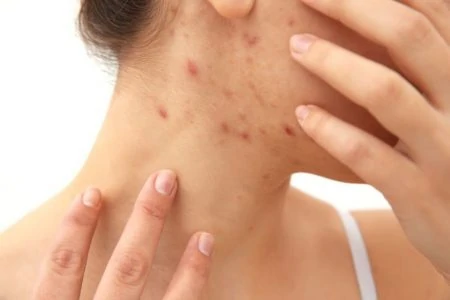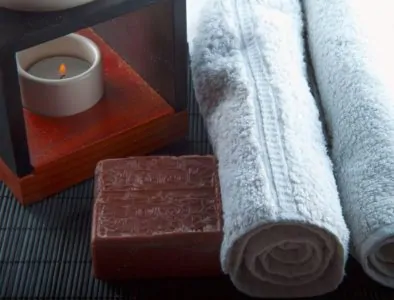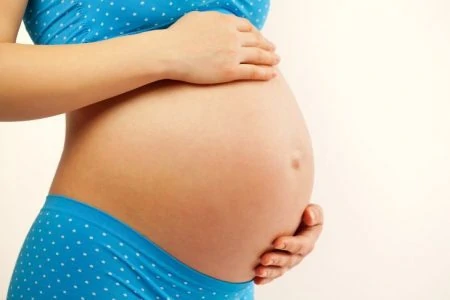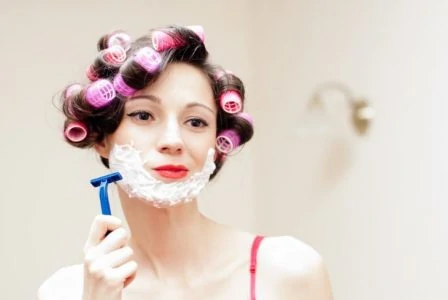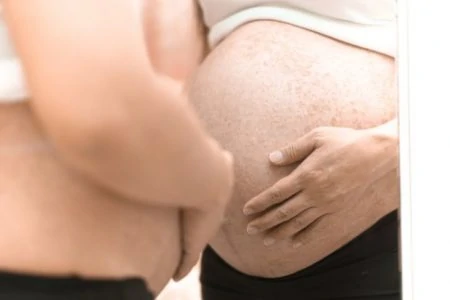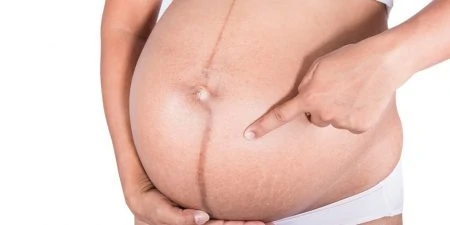After learning we are pregnant, many of us feel excited about the changes in store. We can’t wait to grow a cute little baby bump. And we’ve all heard of the pregnancy glow.
It’s easy to develop an unrealistic image that being pregnant will make us look flawless. However, you’re more likely to deal with pregnancy acne, varicose veins, and swelling in every limb.
These pregnancy changes even extend to our hair. While some of these changes are positive, others are not so fun to deal with.
We’ve talked with the experts about hair changes during pregnancy to learn why this happens and what we can expect. We’ll share our findings here. We’ll also discuss whether it’s safe to use hair treatments during pregnancy.
Key Takeaways
- Hair changes during pregnancy include increased volume, potential hair loss, dry scalp, dandruff, and oily hair.
- Hormonal changes are responsible for most of these hair changes, and they usually resolve after giving birth.
- To maintain hair health during pregnancy, focus on a balanced diet, staying hydrated, and managing stress.
- Coloring hair, perms, and some straightening treatments are generally considered safe during pregnancy, but consult your doctor if you have any concerns.
Hair Changes During Pregnancy
Many things happen to a woman’s hair during pregnancy. You may be excited about these changes, or you may find them frustrating.
1. Volume!
A few weeks into your pregnancy, you may notice fewer hair strands left in your brush. Fast forward a month or so, and you’re suddenly sporting longer, thicker hair.
Pregnancy doesn’t magically cause your hair strands to thicken, but it can prevent you from losing as much hair.
When we are not pregnant, about 85% to 95% of our hair is growing. The other 5% to 15% is in a resting phase, getting ready to shed.
As you brush or wash your hair, the strands finally loosen their grip and fall out. On average, women shed approximately 100 hairs every day. Then new strands begin to grow, replacing what is lost.
As we produce extra hormones during pregnancy, this shedding cycle is interrupted. Higher estrogen levels prolong the hair growth phase and delay the shedding, resulting in thicker hair (1).
It’s also not uncommon for these extra hormones to cause shinier, straighter, or curlier hair.
The Downside
2. Hair Loss
Hair loss is not a common side effect of pregnancy, as the overproduction of hormones tends to work in the opposite way, making hair more voluminous.
However, some women may experience hair loss during pregnancy. This is usually an indicator of vitamin or mineral deficiency rather than a pregnancy side effect. This generally reverses once you regain the appropriate level of nutrients.
When people talk about hair loss and pregnancy, they’re typically referring to the excessive shedding that occurs afterward. Once you’ve given birth, hormone levels return to normal. This triggers postpartum hair loss, which occurs as the follicles rejuvenate.
So make sure you enjoy your luscious locks while they last. The shedding phase typically occurs during the first months postpartum and peaks around the fourth month.
It can be overwhelming to notice increased hair loss, but it is totally normal. Your hair may become quite thin during this time, but don’t worry; it will grow back eventually.
3. Dry Scalp
A dry, itchy scalp is one of the annoying side effects of pregnancy. This symptom generally takes you by surprise during the third trimester. However, some women may suffer from this itching for the whole nine months.
These are some of the factors that can lead to a dry scalp during pregnancy:
Poor Diet
During pregnancy, some of us get all kinds of crazy cravings, while others might struggle to keep even toast down. This can all contribute to a poor diet, where you’re not receiving a sufficient amount of nutrients.
You can easily treat this by talking with your doctor or midwife. They may recommend a change of diet or prescribe some supplements.
Excessive Stress and Anxiety
Studies have revealed that our skin is vulnerable to stress. When we experience excessive pressure, it induces inflammation and immune responses in our skin — including the skin on our scalp (2).
While we’re pregnant, it’s common for us to experience increased stress. This could be worrying about labor, other symptoms, or maybe even personal matters.
Dehydration
Dehydration is common during pregnancy. Your body needs fluids now more than ever. As well as drinking more water, you should try to avoid caffeine (sob!).
Depriving your body of fluids will show in your skin — including your scalp. Dehydration can also lead to constipation, making a dry scalp worse.
If you’re constantly feeling like you are overheating, this could be an indicator of dehydration. Preventing dry skin is a lot easier than treating it.
How to Treat a Dry Scalp
You can use a prescription or over-the-counter shampoo to relieve dry scalp. Look for those containing selenium or zinc pyrithione. Apply like a regular shampoo, and let it sit for five minutes before rinsing it off.
If your dry scalp is due to dehydration, make sure you up your fluid intake. You should also apply mild, moisturizing products to the area.
However, if you feel excessive itchiness, consult your doctor. They may recommend a different topical cream or order some tests to eliminate other causes.
You can also prevent dry skin by improving your diet. Make sure you include foods containing the required nutrients. These are some good options:
- Fresh fruits.
- Vegetables.
- Fish.
- Nuts and seeds.
Avoid eating foods containing saturated fats and butter, and try to reduce your intake of fried food.
Dry scalp or not, you need to drink plenty of water. You should ideally drink about 10 cups of water a day during pregnancy. Staying hydrated will not only improve your skin but also help liver and bowel functions.
4. Dandruff
Dandruff is a skin condition affecting the scalp. It causes flaking and itchiness, usually due to a faster shedding process triggered by a specific event.
If you are experiencing dandruff during your pregnancy, you are not alone. This is yet another common pregnancy side effect. Let’s explore three common causes.
Increased Oil Production
Pregnancy will increase our body’s oil production. When this affects the scalp, it results in much more efficient production of newer cells.
As the newer cells develop, the old must discharge. This also occurs at a much higher speed than before, which is why you’ll notice more flakes on your scalp.
Product Sensitivity
Sometimes we can’t blame our hard-working bodies. It’s time to point the finger at those hair products.
Pregnancy can cause us to be ultra-sensitive to chemicals and additives. As we apply products such as shampoos or oils, our skin responds by producing more cells to protect the area.
Products you used without issues before pregnancy may now cause dandruff.
Overreactions
Pregnant bodies tend to get overprotective. During gestation, our body suddenly sees various microorganisms (even good bacteria) as dangerous bacteria or germs. This is an amazing feature that protects your baby against biological harm.
However, it can be inconvenient. To fight these bacteria, your scalp begins to shed the outer skin cells, resulting in dandruff. It might also itch or feel irritated.
Treating Dandruff During Pregnancy
Dandruff during pregnancy is treatable. However, you should choose a special pregnancy-safe shampoo, such as those containing the following ingredients:
- Ketoconazole: An antifungal agent.
- Pyrithione zinc: Has antibacterial and antifungal properties.
- Selenium sulfide: Slows the aging of cells that prolongs shedding.
- Tar-based: Also prolongs the process and may help treat other conditions.
You can also try any of the following natural remedies:
- Apple cider vinegar: Holds anti-inflammatory properties that clean the scalp of dandruff-causing fungus. Apply overnight and rinse in the morning.
- Aloe vera: Helps remove yeast and fungus with its natural antifungal traits. Apply pure aloe directly onto the scalp and massage it in.
- Garlic and argan oil: Helps improve blood flow while removing impurities. Finely chop the garlic, mix with argan oil, and rub it on the scalp.
- Coconut oil: Holds antifungal agents, among other nutrients known to fight dandruff. Warm the oil and apply it to the scalp. Remove it after an hour.
- Sea salt: Add a couple of tablespoons to an oil-infused shampoo to exfoliate your scalp. Apply a moisturizer after.
There are also a few ways you can prevent dandruff from occurring:
- Manage stress: Try different methods of managing your stress, such as yoga, warm baths, or — my favorite — binge-watching Netflix.
- Proper diet: Foods rich in vitamin B and zinc can help regenerate the skin, boost immunity, and optimize metabolism.
- Proper hair care: Keep your scalp clean using an anti-dandruff shampoo to help prevent it from becoming an issue.
5. Oily Hair
While some women may enjoy a thicker head of hair, others must endure nine months of greasy locks.
This common symptom is another result of the surging hormones. Hormone production goes into overdrive to compensate for the changes occurring.
For some women, this means increased sebum production in the hair follicles, leading to greasy hair.
The intensity all depends on your genetic makeup. For some women, it may also affect their facial area — causing greasy skin and acne breakouts.
However, these same oil glands can also slow down during pregnancy, causing frizzy hair or dandruff.
Fortunately, there are ways you can help reduce the amount of oil in your hair.
Skip the Conditioner
While experts usually recommend we condition our hair after shampooing, during an outbreak of pregnancy-induced oily hair, it’s better not to. I’ve had great results by avoiding conditioner while showering and using only a tiny amount of leave-in conditioner to help me brush through my hair afterward.
The grease build-up is a naturally-occurring moisturizer, so you’re overdosing on the stuff by using conditioner. This worsens your hair’s appearance by making it even more greasy.
Shampoo Less Frequently
This may sound ridiculous, but shampooing your hair excessively can backfire.
Your shampoo cleans your hair of dirt, residue, oil, and grease. The oil glands on your scalp will compensate to prevent dehydration. They begin to produce even more oil, further increasing the grease on your scalp.
The best thing to do is to use a mild shampoo and wash your hair no more than two or three times a week.
Improving your diet and reducing stress will also help regulate your oily hair.
Hair Treatments During Pregnancy
It’s only natural for us to want to look our best, and this is just as true during pregnancy. It gives us more confidence, makes us feel sexy, and brings out our best from within. But now that you’re pregnant, there are some precautions to consider.
Below are a few hair treatments you should think twice about when you’re expecting.
1. Coloring Hair
I always thought this was a big no-no. Yet doctors say it’s safe to dye your hair while pregnant. Most research into the chemicals found in semi-permanent and permanent dyes reveals they are not highly toxic.
These chemicals are not injected into the bloodstream. They are only applied to the hair strands and scalp. Your skin may absorb some of the substances; however, it’s just a minimal amount, if any.
This tiny amount has little to no chance of reaching your unborn baby.
The most important consideration is to dye your hair in a well-ventilated area. You want to avoid breathing in fumes as much as possible.
Safety First
You could also use natural plant-based dyes, such as henna, as these do not contain chemicals. However, make sure you are not allergic first.
If you choose to try your hand at henna, ensure you get a pure product with no additives. These do limit your color choices to brown and red. But you can add natural colors such as indigo to darken it or give it a blue hue.
If you want to lighten your color, spray some fresh lemon juice on your hair and let it dry in the sun. Lemon juice works as a mild bleach that you then enhance with the sun. Just ensure you apply sunscreen to your skin and don’t stay out too long.
You could also opt for a little touch-up instead and go with a few highlights. This will decrease the amount of dye placed on your scalp, thus minimizing your exposure.
2. Perms
A perm, or permanent, is where you use chemicals or heat to create a curly look that lasts a month or more. This fun retro hairstyle is making a comeback.
Salons use quite a few chemicals to make straight hair curly. It’s a process that includes breaking and reforming the hair’s structure.
Fortunately, for all you regular perm mammas, getting a perm while pregnant is safe (4).
Like with hair dyes, there still needs to be more research on the subject, but the body absorbs little of the chemicals used.
However, you may be disappointed with the perm’s results. Your hair texture can change dramatically during pregnancy. This can interfere with the outcome of the treatment, and it may fall flat — as mine did.
For Cosmetologists
Although studies have been minimal, one revealed that female cosmetologists need to be careful during pregnancy. Those who work 40 hours a week and are often exposed to bleaches and hair dyes may have an increased risk of miscarriage (5).
However, you can prevent this miscarriage risk with proper working conditions and precautions. Wear gloves when dealing with hair treatments, and keep the room well ventilated to minimize fume exposure.
3. Straightening Treatments
Some women may wish to reduce frizzy hair during pregnancy. And others may simply prefer a straight look as opposed to curly.
We commonly resort to chemical treatments to straighten our hair, such as relaxers, keratin straightening, or Brazilian blowouts.
But are these treatments safe? Let’s look at them individually.
Relaxer
A relaxer is when you apply chemical creams or lotions to your hair. These will “relax” any curl or frizz, making it easier to manage.
Much like hair dye, the chemicals used in a relaxer aren’t absorbed into the bloodstream. Experts consider relaxers safe to use in moderation, but always err on the side of caution. There is still no evidence of side effects to the fetus.
Keratin Straightening Treatment and Brazilian Blowout
If you’re planning to get a Brazilian blowout or keratin straightening treatment done while pregnant, you should reschedule. Of all the treatments on our list, this is the one to avoid (6).
These treatments take a lot of time, meaning you’re exposed to the chemical fumes for longer. Besides that, our skin tends to absorb these readily. Some studies have even shown that long-term exposure to keratin treatments can cause cancer.
A 2013 study found a link between hair straightening cosmetics use during pregnancy and the development of childhood cancers like leukemia in children under 2 years old (7).
Editor's Note:
Caitlin Goodwin, MSN, RN, CNMIt’s best to avoid this treatment and keep your natural curls until after delivery.
FAQs
Let Your Hair Down
Pregnancy alters a lot about a woman’s body — our belly grows, our ankles swell, and sometimes our hair takes on a new look.
Depending on your genetic makeup, pregnancy might make your locks appear voluminous, luscious, and healthy. For others, dry scalp, dandruff, frizz, or oily hair may be more realistic.
We love to switch up our look; luckily, most treatments are deemed safe to carry out while pregnant. However, it’s always best to do it in moderation, if at all.






